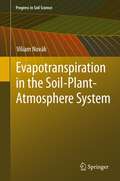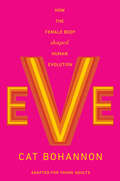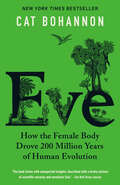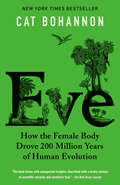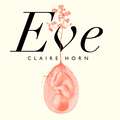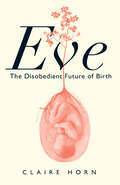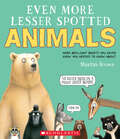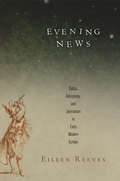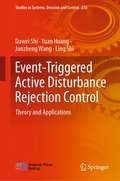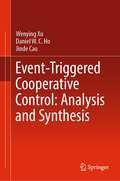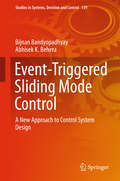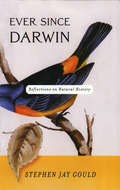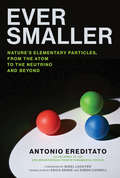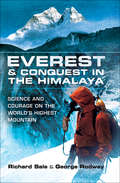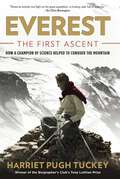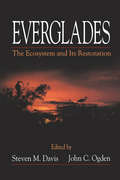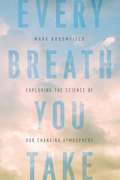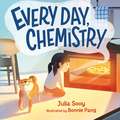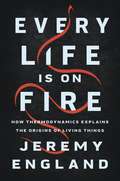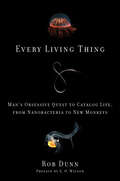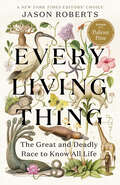- Table View
- List View
Evapotranspiration in the Soil-Plant-Atmosphere System
by Viliam NovakEvapotranspiration and its components (evaporation and transpiration) as a process is one of the basic terms of Earth's water balance; its importance is accented by the fact that transpiration is the vital element of the biomass production process. The second important property of evapotranspiration is its extreme consumption of solar energy, thus controlling the temperature of the atmosphere and creating favourable conditions for life. Evapotranspiration as an energy consuming process is also the connection between the energy and mass cycles of the Earth. Evapotranspiration is a process performing in the Soil-Plant -Atmosphere System (SPAS); therefore this book is presenting and quantifying it as a catenary process, describing transport of water in the soil, including root extraction patterns and methods of its evaluation. Transport of water through the plant and from the canopy to the atmosphere is also described and quantified. A variety of evapotranspiration (and its components evaporation and transpiration) calculation methods are described, starting from empirical methods up to the most sophisticated ones based on the solution of the transport equations of water and energy in the SPAS. The most important (and widely used) calculation method - modified Penman-Monteith method is described in details, ready to be used with data in the book only. Water balance method of evapotranspiration estimation as well as sap flow method description can be found in the book as well. The book can be used by hydrologists, biologists, meteorologists and other specialists as well as by ecology students. Key themes: soil hydrology - evapotranspiration - hydropedology- plant physiology - water movement in soils - evaporation - transpiration Dr. Viliam Novák is a water resources scientist at the Institute of Hydrology of the Slovak Academy of Sciences in Bratislava (Slovakia).
Eve (Adapted for Young Adults): How the Female Body Shaped Human Evolution
by Cat BohannonThe groundbreaking New York Times bestseller is now adapted for young adults! This is the 200-million-year story of how the female body gave rise to the human species and forever shaped life on Earth and what that means for us in the future.Why do women live longer than men? Why do girls score better at every academic subject than boys until puberty, when suddenly their scores plummet? Is the female brain "wired differently?" These questions and common debates around scientific claims are thoughtfully examined in this adaptation perfect for young people.This brand-new adaptation is a friendly, funny, and engaging read. It explores teen related topics such as mental health and the biology behind it, including insights on how adolescent brains are going through all kinds of changes, and shifting hormones. Author Cat Bohannon explains the roots of sexism and shows how, though it may have even served some evolutionary purpose long ago, it no longer serves us today, and it&’s high time we leave it in the past.Filled with amazing stories of both past and present, Eve will delight any young reader looking to understand the body—its amazing history, its wondrous capability, its oddities and mysteries, and its relevance to so many issues captivating contemporary thought and discussion.
Eve: How the Female Body Drove 200 Million Years of Human Evolution
by Cat BohannonAn ambitious, eye-opening, myth-busting and groundbreaking history of the evolution of the female body, by a brilliant new researcher and writer.Why do women live longer than men? Why do women have menopause? Why are women more likely to get Alzheimer&’s? Why do girls score better at every academic subject than boys until puberty, when suddenly their scores plummet? And does the female brain really exist?In Eve, Cat Bohannon answers questions scientists should have been addressing for decades. With boundless curiosity and sharp wit, she covers the past 200 million years to explain the specific science behind the development of the female sex. Eve is not only a sweeping revision of human history, it&’s an urgent and necessary corrective for a world that has focused primarily on the male body for far too long. Bohannon&’s findings, including everything from the way C-sections in the industrialized world are rearranging women&’s pelvic shape to the surprising similarities between pus and breast milk, will completely change what you think you know about evolution and why Homo sapiens have become such a successful and dominant species, from tool use to city building to the development of language.A 21st-century update of Our Bodies, Ourselves, Eve offers a true paradigm shift in our thinking about what the female body is and why it matters.
Eve: How the Female Body Drove 200 Million Years of Human Evolution
by Cat Bohannon&“A page-turning whistle-stop tour of mammalian development that begins in the Jurassic Era, Eve recasts the traditional story of evolutionary biology by placing women at its center…. The book is engaging, playful, erudite, discursive and rich with detail." —The New York Times&“A smart, funny, scientific deep-dive into the power of a woman&’s body, Eve surprises, educates, and emboldens.&”—Bonnie Garmus, #1 New York Times best-selling author of Lessons in ChemistryAn ambitious, eye-opening, myth-busting and groundbreaking history of the evolution of the female body, by a brilliant new researcher and writerWhy do women live longer than men? Why do women have menopause? Why are women more likely to get Alzheimer&’s? Why do girls score better at every academic subject than boys until puberty, when suddenly their scores plummet? And does the female brain really exist?In Eve, Cat Bohannon answers questions scientists should have been addressing for decades. With boundless curiosity and sharp wit, she covers the past 200 million years to explain the specific science behind the development of the female sex. Eve is not only a sweeping revision of human history, it&’s an urgent and necessary corrective for a world that has focused primarily on the male body for far too long. Bohannon&’s findings, including everything from the way C-sections in the industrialized world are rearranging women&’s pelvic shape to the surprising similarities between pus and breast milk, will completely change what you think you know about evolution and why Homo sapiens have become such a successful and dominant species, from tool use to city building to the development of language.A 21st-century update of Our Bodies, Ourselves, Eve offers a true paradigm shift in our thinking about what the female body is and why it matters.
Eve: How the Female Body Drove 200 Million Years of Human Evolution
by Cat BohannonNEW YORK TIMES BESTSELLER • WOMEN'S PRIZE FOR NON-FICTION FINALIST • THE REAL ORIGIN OF OUR SPECIES: a myth-busting, eye-opening landmark account of how humans evolved, offering a paradigm shift in our thinking about what the female body is, how it came to be, and how this evolution still shapes all our lives today &“A page-turning whistle-stop tour of mammalian development that begins in the Jurassic Era, Eve recasts the traditional story of evolutionary biology by placing women at its center…. The book is engaging, playful, erudite, discursive and rich with detail." —Sarah Lyall, The New York Times &“A smart, funny, scientific deep-dive into the power of a woman&’s body, Eve surprises, educates, and emboldens.&”—Bonnie Garmus, #1 New York Times best-selling author of Lessons in Chemistry How did the female body drive 200 million years of human evolution? • Why do women live longer than men? • Why are women more likely to get Alzheimer&’s? • Why do girls score better at every academic subject than boys until puberty, when suddenly their scores plummet? • Is sexism useful for evolution? • And why, seriously why, do women have to sweat through our sheets every night when we hit menopause? These questions are producing some truly exciting science – and in Eve, with boundless curiosity and sharp wit, Cat Bohannon covers the past 200 million years to explain the specific science behind the development of the female sex: &“We need a kind of user's manual for the female mammal. A no-nonsense, hard-hitting, seriously researched (but readable) account of what we are. How female bodies evolved, how they work, what it really means to biologically be a woman. Something that would rewrite the story of womanhood. This book is that story. We have to put the female body in the picture. If we don't, it's not just feminism that's compromised. Modern medicine, neurobiology, paleoanthropology, even evolutionary biology all take a hit when we ignore the fact that half of us have breasts. So it's time we talk about breasts. Breasts, and blood, and fat, and vaginas, and wombs—all of it. How they came to be and how we live with them now, no matter how weird or hilarious the truth is.&” Eve is not only a sweeping revision of human history, it&’s an urgent and necessary corrective for a world that has focused primarily on the male body for far too long. Picking up where Sapiens left off, Eve will completely change what you think you know about evolution and why Homo sapiens has become such a successful and dominant species.
Eve: The Disobedient Future of Birth
by Claire HornThroughout human history, every single one of us has been born from a person. So far. But that is about to change.Scientific research is on the cusp of being able to grow babies outside human bodies, from machines, for the very first time. Claire Horn takes us on a truly radical and urgent deep dive into the most challenging and pertinent questions of our age. Could artificial wombs allow women to redistribute the work of gestating? How do we protect reproductive and abortion rights? And who exactly gets access to this technology, in ourvastly unequal world?In this interrogative and fascinating story of modern birth, Eve imagines with eyeopening clarity what all this might mean for the future of humanity.
Eve: The Disobedient Future of Birth
by Claire HornA radical interrogation of the ethics and future of birth by an expert legal scholar. Every single one of us has been born from a person. So far. But that is about to change. For the first time, babies could be gestated and born from machines through “Ex-vivo Uterine Environment Therapy,” aka EVE. But such radical technology leaves us with complex legal, social, and ethical questions. What does this breakthrough in artificial human gestation mean for motherhood, womanhood, and parenthood? Countries and people that do not respect the autonomy of pregnant people may use these technologies to curtail choice further, advance eugenic ideas, or to deepen class and racial divides. In this fascinating story of modern birth, Claire Horn takes us on a journey from the first orchid-like incubators in the 1880s to the cutting-edge scientific breakthroughs of today. As she explores the most challenging and pertinent questions of our age, Horn reflects on her own pregnancy. Could artificial wombs allow women to redistribute the work of gestating? How do we protect reproductive and abortion rights? And who exactly gets access to this technology, in our vastly unequal world?
Even More Fizzle, Bubble, Pop & Wow!
by Lisa MurphyExcite young learners with this collection of more than 80 simple science experiments. Each activity promotes learning and requires materials that are likely already in your classroom or kitchen. Each fun activity includes simple instructions and a clear explanation of the experiment-and many include variations and helpful hints.
Even More Lesser Spotted Animals
by Martin BrownApproachable and funny, Even More Lesser Spotted Animals combines the humor and verve of Sandra Markle with the gorgeous presentation of picture books from Steve Jenkins and Diana Aston.Just as Lesser Spotted Animals showed you some of the wonderfully WOW wildlife we never get to see, the next book of the lesser known animal kingdom reveals the stories of even more of the world's unseen and unsung creatures. No king-of-the-jungle, fancy-pants, hair necked lions here -- we've got the magnificent maned wolf instead. No blue whales either, we've got beaked whales -- and lorises and dingisos and dibatags and many, many more.
Evening News
by Eileen ReevesEileen Reeves examines a web of connections between journalism, optics, and astronomy in early modern Europe, devoting particular attention to the ways in which a long-standing association of reportage with covert surveillance and astrological prediction was altered by the near simultaneous emergence of weekly newsheets, the invention of the Dutch telescope, and the appearance of Galileo Galilei's astronomical treatise, The Starry Messenger.Early modern news writers and consumers often understood journalistic texts in terms of recent developments in optics and astronomy, Reeves demonstrates, even as many of the first discussions of telescopic phenomena such as planetary satellites, lunar craters, sunspots, and comets were conditioned by accounts of current events. She charts how the deployment of particular technologies of vision--the telescope and the camera obscura--were adapted to comply with evolving notions of objectivity, censorship, and civic awareness. Detailing the differences between various types of printed and manuscript news and the importance of regional, national, and religious distinctions, Evening News emphasizes the ways in which information moved between high and low genres and across geographical and confessional boundaries in the first decades of the seventeenth century.
Evening's Empire
by Craig KoslofskyWhat does it mean to write a history of the night? Evening's Empire is a fascinating study of the myriad ways in which early modern people understood, experienced, and transformed the night. Using diaries, letters, and legal records together with representations of the night in early modern religion, literature and art, Craig Koslofsky opens up an entirely new perspective on early modern Europe. He shows how princes, courtiers, burghers and common people 'nocturnalized' political expression, the public sphere and the use of daily time. Fear of the night was now mingled with improved opportunities for labour and leisure: the modern night was beginning to assume its characteristic shape. Evening's Empire takes the evocative history of the night into early modern politics, culture and society, revealing its importance to key themes from witchcraft, piety, and gender to colonization, race, and the Enlightenment.
Event Classification in Liquid Scintillator Using PMT Hit Patterns: for Neutrinoless Double Beta Decay Searches (Springer Theses)
by Jack DungerThe search for neutrinoless double beta decay is one of the highest priority areas in particle physics today; it could provide insights to the nature of neutrino masses (currently not explained by the Standard Model) as well as how the universe survived its early stages. One promising experimental approach involves the use of large volumes of isotope-loaded liquid scintillator, but new techniques for background identification and suppression must be developed in order to reach the required sensitivity levels and clearly distinguish the signal. The results from this thesis constitute a significant advance in this area, laying the groundwork for several highly effective and novel approaches based on a detailed evaluation of state-of-the-art detector characteristics. This well written thesis includes a particularly clear and comprehensive description of the theoretical motivations as well as impressively demonstrating the effective use of diverse statistical techniques. The professionally constructed signal extraction framework contains clever algorithmic solutions to efficient error propagation in multi-dimensional space. In general, the techniques developed in this work will have a notable impact on the field.
Event-Triggered Active Disturbance Rejection Control: Theory and Applications (Studies in Systems, Decision and Control #356)
by Dawei Shi Ling Shi Yuan Huang Junzheng WangThe past few years have seen the attention and rapid developments in event-triggered sampled-data systems, in which the effect of event-triggered sensor measurements and controller updates is explored in controller analysis and design.This book offers the first systematic treatment of event-triggered sampled-data control system design using active disturbance rejection control (ADRC), an effective approach that is popular in both theoretic research and industrial applications. Extensive application examples with numerous illustrations are included to show how the event-triggered ADRC with theoretic performance guarantees can be implemented in engineering systems and how the performance can be actually achieved. For theoretic researchers and graduate students, the presented results provide new directions in theoretic research on event-triggered sampled-data systems; for control practitioners, the book offers an effective approach to achieving satisfactory performance with limited sampling rates.
Event-Triggered Cooperative Control: Analysis and Synthesis
by Jinde Cao Wenying Xu Daniel W. HoThe book provides a systematic and in-depth introduction to distributed event-triggered cooperative control for multi-agent systems from a theoretical perspective, which will be of particular interest to the readers. The included major research topics include: a unified design and analysis framework for centralized, clustered and distributed event-triggered schemes; fully distributed design for event/self-triggered schemes; resilient event-triggered control under malicious attacks; and various methods to aovid Zeno behavior. The comprehensive and systematic treatment of event-triggered communication and control in multi-agent system is one of the major features of the book, which is particularly suited for readers who are interested in learning principles and methods to deal with communication constraints in multi-agent systems and to design energy-saving control protocols. The book can benefit researchers, engineers, and graduate students in the fields of complex networks, smart grids, applied mathematics, electrical and electronic engineering, and computer engineering, etc.
Event-Triggered Sliding Mode Control: A New Approach To Control System Design (Studies In Systems, Decision And Control #139)
by Bijnan Bandyopadhyay Abhisek K. BeheraThis edited monograph provides a comprehensive and in-depth analysis of sliding mode control, focusing on event-triggered implementation. The technique allows to prefix the steady-state bounds of the system, and this is independent of any boundary disturbances. The idea of event-triggered SMC is developed for both single input / single output and multi-input / multi-output linear systems. Moreover, the reader learns how to apply this method to nonlinear systems. The book primarily addresses research experts in the field of sliding mode control, but the book may also be beneficial for graduate students.
Ever Since Darwin: Reflections in Natural History
by Stephen Jay GouldMore than any other modern scientists, Stephen Jay Gould has opened up to millions the wonders of evolutionary biology. His genius as an essayist lies in his unmatched ability to use his knowledge of the world, including popular culture, to illuminate the realm of science. Ever Since Darwin, Stephen Jay Gould's first book, has sold more than a quarter of a million copies. Like all succeeding collections by this unique writer, it brings the art of the scientific essay to unparalleled heights.
Ever Smaller: Nature's Elementary Particles, From the Atom to the Neutrino and Beyond
by Antonio EreditatoIdeas, theories, experiments, and unanswered questions in particle physics, explained (with anecdotes) for the general reader.The elementary particles of matter hold the secrets of Nature together with the fundamental forces. In Ever Smaller, neutrino physicist Antonito Ereditato describes the amazing discoveries of the "particle revolution," explaining ideas, theories, experiments, and unanswered questions in particle physics in a way that is accessible (and enjoyable) for the general reader. Ereditato shows us that physics is not the exclusive territory of scientists in white lab coats exclaiming "Eureka" but that its revelations can be appreciated by any reader curious about the mysteries of the universe.
Everest & Conquest in the Himalaya: Science and Courage on the World's Highest Mountain
by Richard Sale George RodwayA history of those who have scaled Mount Everest—and the advances in mountaineering over a century. At one time, the summits of the world&’s highest peaks—Everest included—were beyond reach. Pioneering attempts to overcome the dangers of climbing at extremely high altitudes ended in failure, sometimes with disastrous consequences. Yet today, high-altitude ascents are frequent, almost commonplace. Everest can be conquered by relatively inexperienced mountaineers, and their exploits barely merit media attention—unless they go fatally wrong. This dramatic history of Everest climbs describes in vivid detail the struggle to conquer the mountain and the advances in scientific knowledge that made the conquest possible. It also offers compelling insight into the science of mountaineering—as well as the physical and psychological challenges faced by individuals who choose to test themselves in some of the harshest conditions on earth.
Everest - The First Ascent: How a Champion of Science Helped to Conquer the Mountain
by Harriet TuckeyWinner:Banff Award for Mountain and Wilderness LiteratureThe British Sportsbook Award for Outstanding General Sports WritingThe Boardman Tasker Prize for Mountain LiteratureFinalist for the HW Fisher Biographer's PrizeEverest was not conquered by force of will alone. It required immense planning, research, and preparation. Dr. Griffith Pugh&’s role in the first successful ascent of Everest in 1953 by Edmund Hilary and Tenzing Norgay was absolutely pivotal, yet this story has until now remained untold. As the expedition&’s physiological consultant, Pugh designed almost every aspect of the survival strategy for the expedition, the acclimatisation programme, the oxygen- and fluid-intake regime, the diet, the clothing and the high altitude boots. A spirit of gentleman-amateurism had prevailed previously and this new scientific professionalism ensured the success of the expedition and opened the way for a stunning stream of mountaineering successes. Within five years climbers had scaled nearly all of the world&’s highest peaks in relative safety. Dr. Pugh became known as one of the fathers of altitude medicine, saving the lives of several members of Hillary&’s expedition to Mount Makalu, and pioneering safety techniques for mountaineers and hill walkers.This is also the story of Griffith Pugh, the man, a troubled and eccentric person who had difficulties in sustaining personal relationships in both his personal and professional lives. His daughter and author of this biography, Harriet Tuckey, did not discover the extent of her father&’s role in the success of the climb until he was honored late in life at the Royal Geographical Society. His story shines a necessary and fascinating light on one of mankind's greatest achievments.
Everglades: The Ecosystem and Its Restoration
by Steve Davis John C. OgdenThe 31 chapters provide a wealth of previously unpublished information, plus topic syntheses, for a wide range of ecological parameters. These include the physical driving forces that created and continue to shape the Everglades and patterns and processes of its flora and fauna. The book summarizes recent studies of the region's vegetation, alligat
Every Breath You Take: Exploring the Science of Our Changing Atmosphere
by Mark BroomfieldA leading authority in the field takes readers on a fascinating and surprising journey through the atmosphere—from our lungs to outer space—that will leave readers breathless.With seven million early deaths each year linked to air pollution, air quality is headline news around the world. But even though we breathe in and out every few seconds, few of us really know what&’s in the air all around us. In Every Breath You Take, air quality specialist—and full-time breather—Dr. Mark Broom connects the dots from the atmosphere on distant planets to the holes in the ozone layer to the particles in our lungs. How do we measure air pollution and what on earth is an odor panel? Why are property prices higher upwind of cities? And will our grandchildren inherit an atmosphere worth breathing? With keen insights on the atmospheric effects of climate change, industrial air pollution, and urbanization in the twenty-first century, Every Breath You Take combines the latest scientific research with Mark&’s personal stories to answer these questions and many more in a readable and surprising journey through the atmosphere.
Every Day, Chemistry
by Julia SooyA mother and daughter go about their day as chemical reactions in their everyday lives occur around them in Everyday Chemistry, a nonfiction picture book by writer Julia Sooy and illustrator Bonnie Pang.Science is all around us in our daily lives. Specifically, chemistry! When your bread toasts, when your shampoo foams, when the playground slide rusts--those are all chemical reactions. In this book, a mother and daughter expereince all these things and more as they go about their day, from when they wake up, to when they go to bed. This story is a great way to introduce young readers into the world of science!
Every Life Is on Fire: How Thermodynamics Explains the Origins of Living Things
by Jeremy EnglandA preeminent physicist unveils a field-defining theory of the origins and purpose of life.Why are we alive? Most things in the universe aren't. And everything that is alive traces back to things that, puzzlingly, weren't. For centuries, the scientific question of life's origins has confounded us. But in Every Life Is on Fire, physicist Jeremy England argues that the answer has been under our noses the whole time, deep within the laws of thermodynamics. England explains how, counterintuitively, the very same forces that tend to tear things apart assembled the first living systems.But how life began isn't just a scientific question. We ask it because we want to know what it really means to be alive. So England, an ordained rabbi, uses his theory to examine how, if at all, science helps us find purpose in a vast and mysterious universe.In the tradition of Viktor Frankl's Man's Search for Meaning, Every Life Is on Fire is a profound testament to how something can come from nothing.
Every Living Thing: Man's Obsessive Quest to Catalog Life, from Nanobacteria to New Monkeys
by Rob DunnBiologists and laypeople alike have repeatedly claimed victory over life. A thousand years ago we thought we knew almost everything; a hundred years ago, too. But even today, Rob Dunn argues, discoveries we can't yet imagine still await.In a series of vivid portraits of single-minded scientists, Dunn traces the history of human discovery, from the establishment of classification in the eighteenth century to today's attempts to find life in space. The narrative telescopes from a scientist's attempt to find one single thing (a rare ant-emulating beetle species) to another scientist's attempt to find everything in a small patch of jungle in Guanacaste, Costa Rica. With poetry and humor, Dunn reminds readers how tough and exhilarating it is to study the natural world, and why it matters.
Every Living Thing: The Great and Deadly Race to Know All Life
by Jason RobertsFrom the bestselling author of A Sense of the World comes this dramatic, globe-spanning and meticulously-researched story of two scientific rivals and their race to survey all life on Earth.In the 18th century, two men dedicated their lives to the same daunting task: identifying and describing all life on Earth. Their approaches could not have been more different. Carl Linnaeus, a pious Swedish doctor with a huckster's flair, believed that life belonged in tidy, static categories. Georges-Louis de Buffon, an aristocratic polymath and keeper of France's royal garden, viewed life as a dynamic swirl of complexities. Both began believing their work to be difficult, but not impossible—how could the planet possibly hold more than a few thousand species? Stunned by life's diversity, both fell far short of their goal. But in the process they articulated starkly divergent views on nature, on humanity's role in shaping the fate of our planet and on humanity itself. The rivalry between these two unique, driven individuals created reverberations that still echo today. Linnaeus, with the help of acolyte explorers he called "apostles" (only half of whom returned alive), gave the world such concepts as mammal, primate and homo sapiens—but he also denied species change and promulgated racist pseudo-science. Buffon coined the term reproduction, formulated early prototypes of evolution and genetics, and argued passionately against prejudice. It was a clash that, during their lifetimes, Buffon seemed to be winning. But their posthumous fates would take a very different turn.With elegant, propulsive prose grounded in more than a decade of research, featuring appearances by Voltaire, Benjamin Franklin and Charles Darwin, bestselling author Jason Roberts tells an unforgettable true-life tale of intertwined lives and enduring legacies, tracing an arc of insight and discovery that extends across three centuries into the present day.
